Growing herbs at home is a budget-friendly way to add freshness to your cooking. If you’re looking to start a herb garden, basil is probably one of your top choices! It’s versatile and can add tons of flavor to your meals. But how long does basil take to grow, and what do you need to know before planting?
You’ve probably tried basil (ocimum basilicum) in dishes like pesto and caprese salad. It’s recognizable thanks to its sweet, anise-like scent and peppery flavor. As part of the mint family, it’s also a low-maintenance herb that can be grown indoors or outdoors.
But just like any plant, basil requires attention and care to thrive! So, before we look at how long it takes for basil to grow, let’s go over some basics to ensure your herb garden is successful.
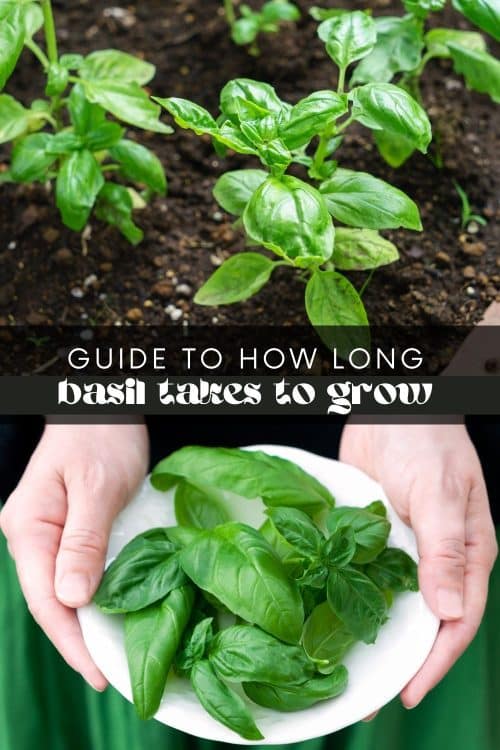
Different Types of Basil
When you think of basil, you probably picture bright green, glossy leaves. However, there are actually over 50 different varieties of basil with varying colors and flavors.
Here are some popular types of basil and their unique characteristics:
- Sweet Basil: This is the classic type of basil with big, green leaves and a sweet flavor. It’s perfect for Italian dishes and pesto.
- Genovese Basil: Similar to sweet basil, but not quite the same, this variety has a stronger aroma and is often used in Italian cooking. Genovese basil and sweet basil are often used interchangeably.
- Thai Basil: With its purple stems and darker leaves, this intense variety is commonly used in Asian cuisine.
- Lemon Basil: As the name suggests, this basil has a citrusy flavor and is great for adding to seafood dishes or cocktails.
- Lime Basil: Another citrus-flavored basil! It’s not as common as lemon basil, but it adds a unique twist to salads and marinades.
- Cinnamon Basil: This type of basil has a unique cinnamon-like flavor. It’s best used in desserts or teas,
- Holy Basil: Also known as Tulsi, this variety has a spicy and clove-like taste. It’s often used in Indian cuisine and is believed to have medicinal properties.
Regardless of what basil variety you choose, they all grow for a similar amount of time!
Throughout this guide, I’ll refer to sweet basil since it’s the most common and easily accessible type. It’s also one of the best herb garden plants!
How Long Does It Take for Basil to Grow?
Sweet basil is an annual plant, meaning it completes its life cycle in one year. It typically takes around 4-6 weeks for it to fully mature. This timeline can vary depending on the growing conditions, such as temperature, sunlight, and soil quality.
You can further break down the growth stages of basil into four phases:
Germination
This is the stage where the seeds start to sprout and form tiny seedlings. It usually takes 5-10 days for basil seeds to germinate.
Seedling
Once the seeds have germinated, they will continue to grow into small plants with their first set of true leaves. At this stage, providing adequate sunlight and water for optimal growth is essential.
Vegetative Growth
During this phase, the plant will grow significantly in size and produce more leaves. This is when you can start harvesting your basil for use in the kitchen.
Flowering
Your basil plant will start to produce flowers at this stage. The flowers are usually white or purple. While this may seem exciting, flowering signals the end of the plant’s life cycle. The basil leaves will also start to lose their flavor, so it’s best to harvest your basil before it reaches this stage.
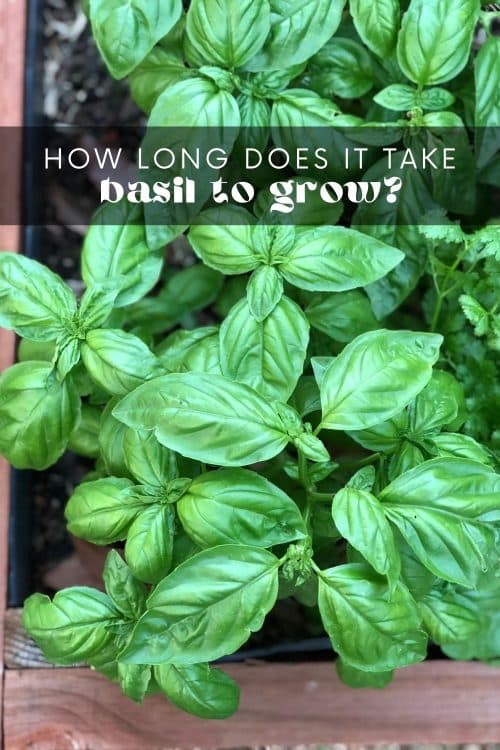
What Is The Best Month to Plant Basil?
The best month to plant basil depends on your location and the climate in your area. Basil likes warm weather and needs a minimum temperature of 50°F to thrive. In most regions, it’s best to plant basil in the spring after the last frost. This ensures that the soil is warm enough for the seeds to germinate.
If you’re growing basil indoors, you can plant it anytime as long as the temperature is consistent and warm.
What Are the Best Growing Conditions for Basil?
Unlike some other herbs, basil is not hardy. This means it can’t withstand extreme temperatures and requires specific growing conditions to thrive. Basil is native to tropical regions and prefers warm temperatures, plenty of sunlight, and well-draining soil.
Soil
A lightweight, well-drained soil with a neutral pH (around 6-7) is ideal for growing basil. If the soil is too compact or waterlogged, it can suffocate the roots and cause root rot. You can add compost or organic matter to improve the soil’s drainage and nutrient levels.
Sunlight
Basil loves sunlight! It requires around 6-8 hours of direct sunlight each day. This is why basil plants are often part of a kitchen window herb garden. If you’re growing basil indoors, place it on a sunny windowsill.
Temperature
As mentioned earlier, basil is native to tropical regions and prefers warm temperatures between 50-80°F (15-26°C). It can tolerate cooler temperatures but will not thrive as well. Make sure to protect your basil plants from cold drafts or extreme temperature fluctuations.
Growing Basil From Seeds vs. Cuttings
When growing basil, you have two options – starting from seeds or using cuttings. Both methods have their advantages, so it ultimately comes down to personal preference. Seeds may take longer to grow, but they offer a wider variety of basil plants to choose from.
On the other hand, cuttings allow you to skip the germination stage. You do have to wait for the cuttings to root before transplanting them, but it’s a great option to prolong the life of an existing basil plant.
Regardless of your chosen method, the key to successfully growing basil is providing the right conditions for growth.
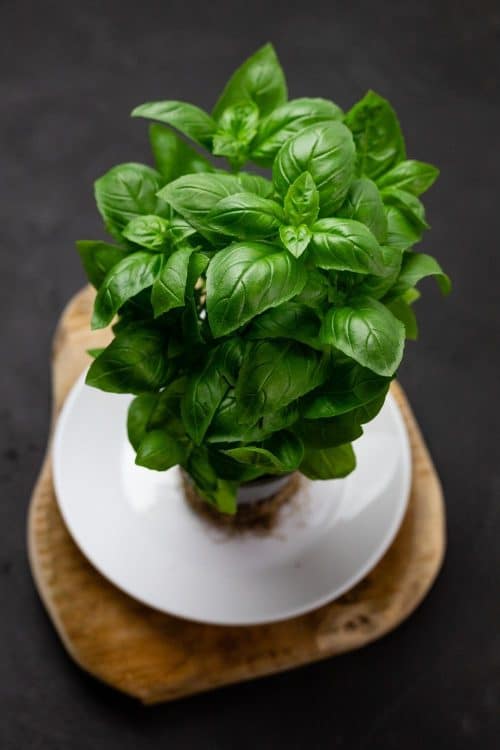
How to Grow Basil From Seed
Your basil seeds must germinate in a warm, well-lit area. You can start them indoors or outdoors, but allowing them to germinate indoors gives you more control over the environment.
Here’s how to grow basil from seed:
- Fill a small container, about 4 inches in diameter, with a potting mix. You can prepare as many pots as you like.
- Lightly moisten the soil and let it drain.
- Scatter the seeds on top of the soil and lightly cover them with a thin layer of potting mix.
- Mist the soil with a little water.
- Cover the container with a plastic wrap to create a greenhouse effect. This helps retain moisture and warmth. There are also seed starting kits that provide a plastic cover you can use instead.
- Keep the container in a warm, well-lit area. The ideal temperature for basil seeds to germinate is between 70-75°F. There’s no need to water your seeds during this time.
- As soon as the seeds start to sprout, remove the plastic wrap and move the container to a sunny location. Use a mister or spray bottle to keep the soil consistently moist but not too wet.
- Once the basil seedlings have grown their first set of true leaves (the second set of leaves that look more like adult basil leaves), you can transplant them into individual pots.
- If you’re moving your basil plants outdoors, hardening them off first is vital. This means gradually introducing them to outdoor conditions such as sunlight and wind over a week. Place them outside for a few hours each day and gradually increase their exposure until they can be planted in the ground or larger containers.
- When transplanting, choose a location with well-draining soil and plenty of sunlight. Remove any weeds and dig a hole slightly larger than the root ball of your basil plant – around 8 inches. If you live somewhere with hot summers, choose a spot with some afternoon shade to protect the plants from scorching.
- Gently remove the seedling from its container and place it in the hole, making sure the top of the root ball is level with the soil. Cover any gaps around the plant with more soil and gently press down to secure it.
Depending on the size of your herb garden and your climate, succession planting can help ensure a steady supply of fresh basil throughout the growing season. This means sowing new seeds every few weeks to replace older plants as they end their lifespan.
How to Grow Basil From Cuttings
You can get your basil cuttings from the grocery store, a garden center, or your own plants. Using cuttings is a great way to propagate basil, as it allows you to produce more plants without buying new seeds.
Here’s how to grow basil from cuttings:
- Start by selecting a healthy, mature plant with plenty of leaves.
- Cut off a section of the stem, about 4-6 inches long, just below a leaf node (where the leaves attach to the stem).
- Remove any lower leaves and trim the top few inches of remaining leaves to reduce water loss.
- Place the cutting in a glass of water. Avoid submerging any leaves in the water.
- Put the glass in a warm, sunny spot and change the water every few days.
- After a week or two, the cutting should start growing roots.
- Once the roots are about an inch long, transplant the cutting into a pot with a well-draining potting mix and follow the steps outlined above for planting basil from seedlings.
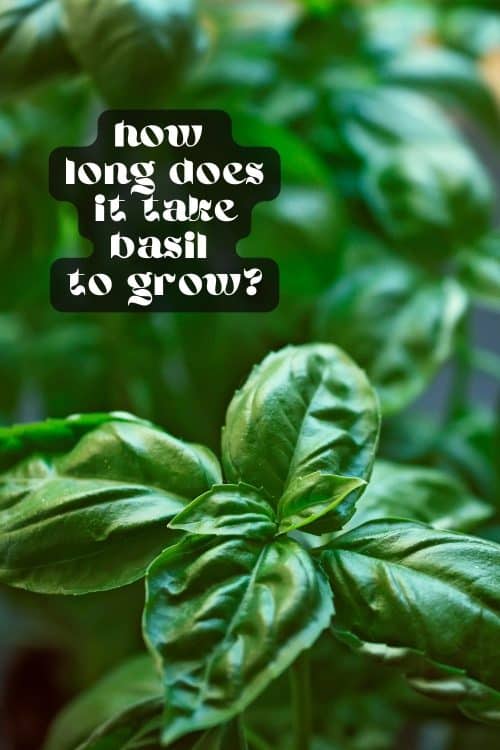
How Often Should You Water Basil?
Basil plants require consistent moisture to thrive but are also susceptible to root rot if overwatered. You should water your basil once a week, but it may need more frequent watering in hot, dry weather.
To check if your plant needs water, stick your finger about an inch into the soil. If it feels dry, then it’s time to water. Indoor plants may require more frequent watering as they are exposed to dry air. If your plants are outdoors, the best time of day to water them is in the morning or evening when the temperature is cooler, and there is less chance of evaporation.
It’s also important to avoid getting water on the leaves of basil plants, as this can lead to fungal diseases.
Basil Plant Care Tips
In addition to proper watering, there are a few other tips to keep in mind when caring for your basil plants:
- Pinch back the leaves: Once your plant is about 6 inches tall, it’s time to start pinching. You do this by removing the top set of leaves just above a node. This will encourage bushier, fuller growth and prevent your plant from getting too tall and leggy.
- Remove flower buds: If your basil plant starts to produce flower buds, it’s important to remove them. This is because once a basil plant flowers, its leaves will lose flavor.
- Avoid bolting: Bolting is when a plant produces flowers and goes to seed prematurely. This usually happens during hot, dry weather. It’s easier to prevent bolting when your basil is in a pot, as you can move it to a shadier spot if needed. If your basil does start to bolt, cut off the flower stalk immediately to encourage more leaf growth.
- Remove weeds: Always remove any weeds. Weeds compete with the basil for water and nutrients, which can cause basil to die off.
- Watch out for pests: Fungus gnats, aphids, and spider mites are common pests that can affect basil plants. Keep an eye out for any signs of infestation, such as yellowing leaves or tiny insects on the plant. If you spot any pests, treat your herb plant with a natural solution or insecticidal soap.
- Fertilize sparingly: Basil plants do not require much fertilizer, if any. If you choose to fertilize, use a balanced fertilizer no more than once or twice during the growing season.
How to Harvest Basil
The most common way to harvest basil is by simply picking the leaves as needed! It’s perfect for adding a fresh pop of flavor to your meals. If you want to harvest a larger amount at once, cut off whole stems rather than individual leaves. Always leave at least a third of the plant intact so it can continue growing.
Even if you don’t need any basil at the moment, it’s important to regularly harvest your plant to encourage new growth! You can store excess basil for later use.
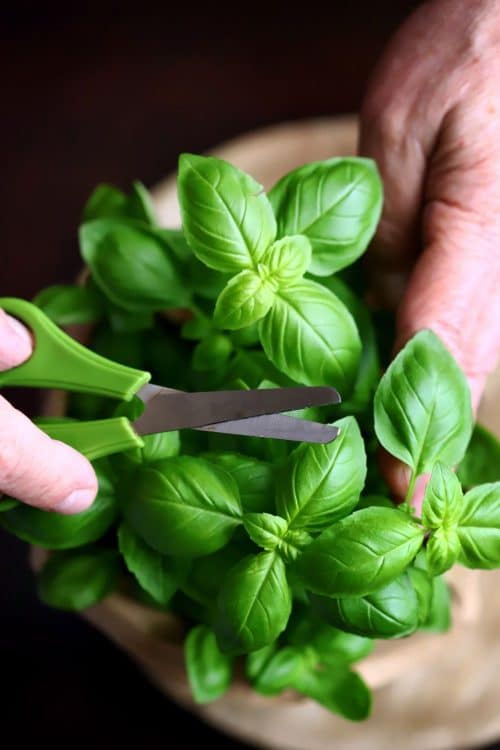
How to Store Basil
You have 3 options for storing fresh basil: room temperature, freezer, or drying.
Let’s take a closer look at each method:
Storing Basil at Room Temperature
For short-term storage, you can keep basil fresh for up to a week by placing it in a glass of water on your kitchen counter (similar to how you would store flowers). Just make sure to change the water daily and watch out for any wilting leaves.
Freezing Basil
To freeze basil, thoroughly wash and dry the leaves, then place them in a single layer on a baking sheet lined with parchment paper. Once frozen, transfer the leaves to an airtight container or bag and store them in the freezer for up to 6 months.
You can also chop or puree the basil and freeze it in an ice cube tray with oil for easy portioning.
Drying Out Basil For Storage
Dried basil is a great option for long-term storage! You can preserve basil by using an herb dehydrator, drying the leaves in the oven, or simply hanging them upside down in a warm and dry place. Crumble the leaves into an airtight container once completely dried.
How to Use Basil
There are so many ways you can enjoy your homegrown basil! Here are some of my favorite ideas:
- Homemade pesto
- Garlic and herb rice
- Slow cooker chicken tenders
- Steak herb butter
- Chicken risotto
- Lemon ricotta pasta
- Bruschetta Caprese
- Garlic herb cheese bread
- Lemon herb salmon
- Added to dog food – basil is a safe herb for dogs!
So whether you make a DIY herb garden or grow a few basil plants in your kitchen, you can have fresh basil in as little as 4-6 weeks! This makes it the perfect herb to have on hand for everyday cooking and adding flavor to your favorite dishes.
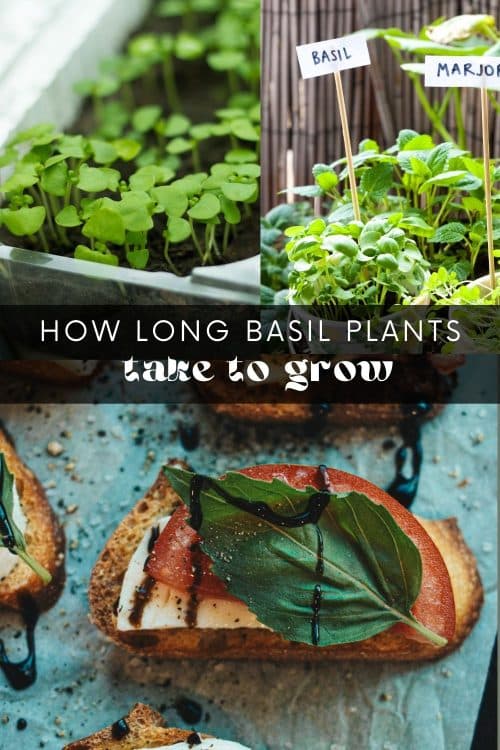
Check out these Herb Posts:
- What Herbs Are Toxic to Dogs?
- DIY Kitchen Window Herb Garden Ideas
- Herb Harvest and Preservation
- Herb Garden Ideas
- How to Get Rid of Gnats on Indoor Herbs
- 12 Best Herb Garden Plants
- 8 Best Indoor Herb Plants
- How to Grow Catmint
- How to Grow Cilantro
- How Long Does It Take Basil to Grow?
- How to Grow Mint Outdoors
- How to Grow Citronella Plants
- How to Grow Mint Indoors
- How to Grow Lavender in Containers
- How to Grow Oregano
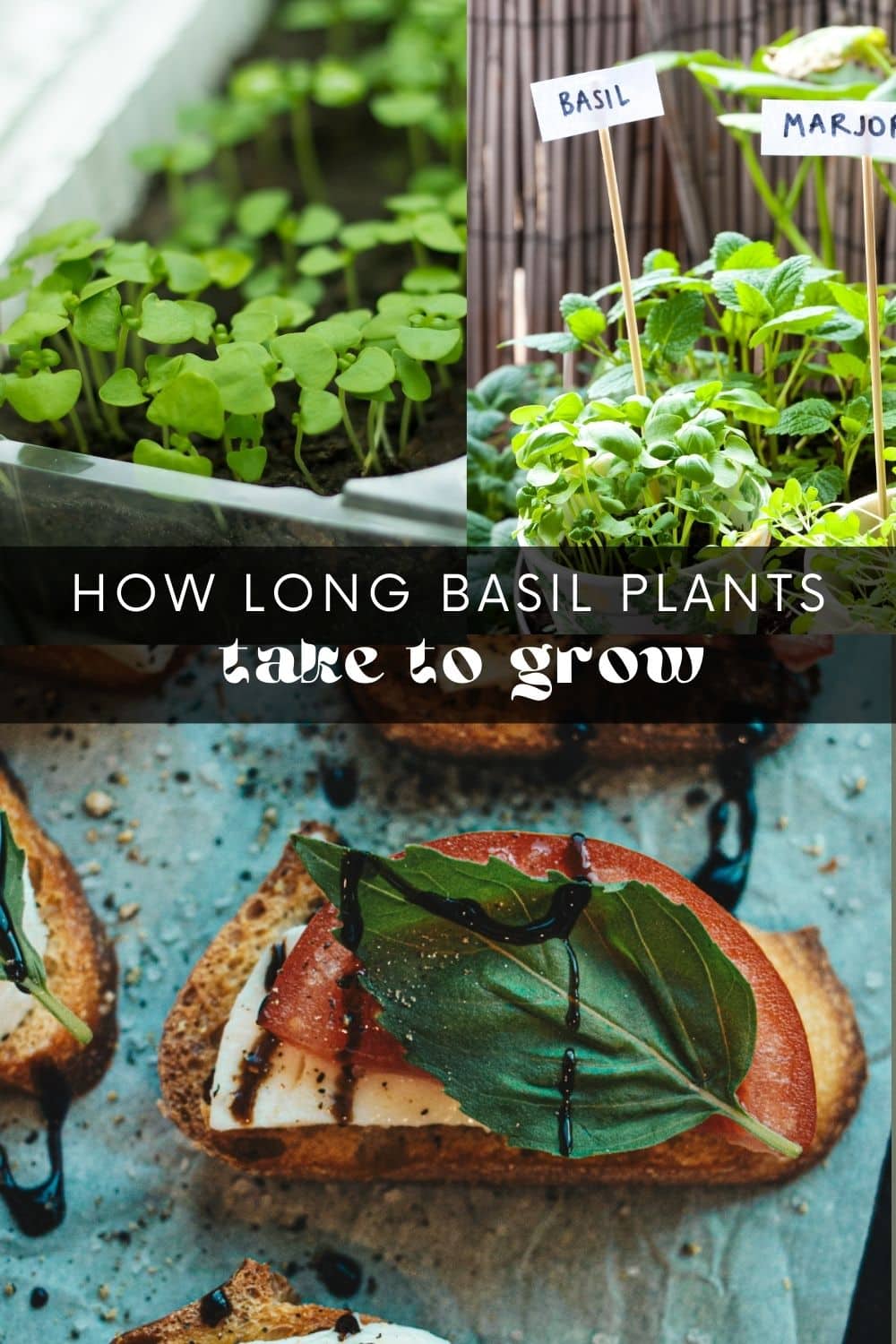
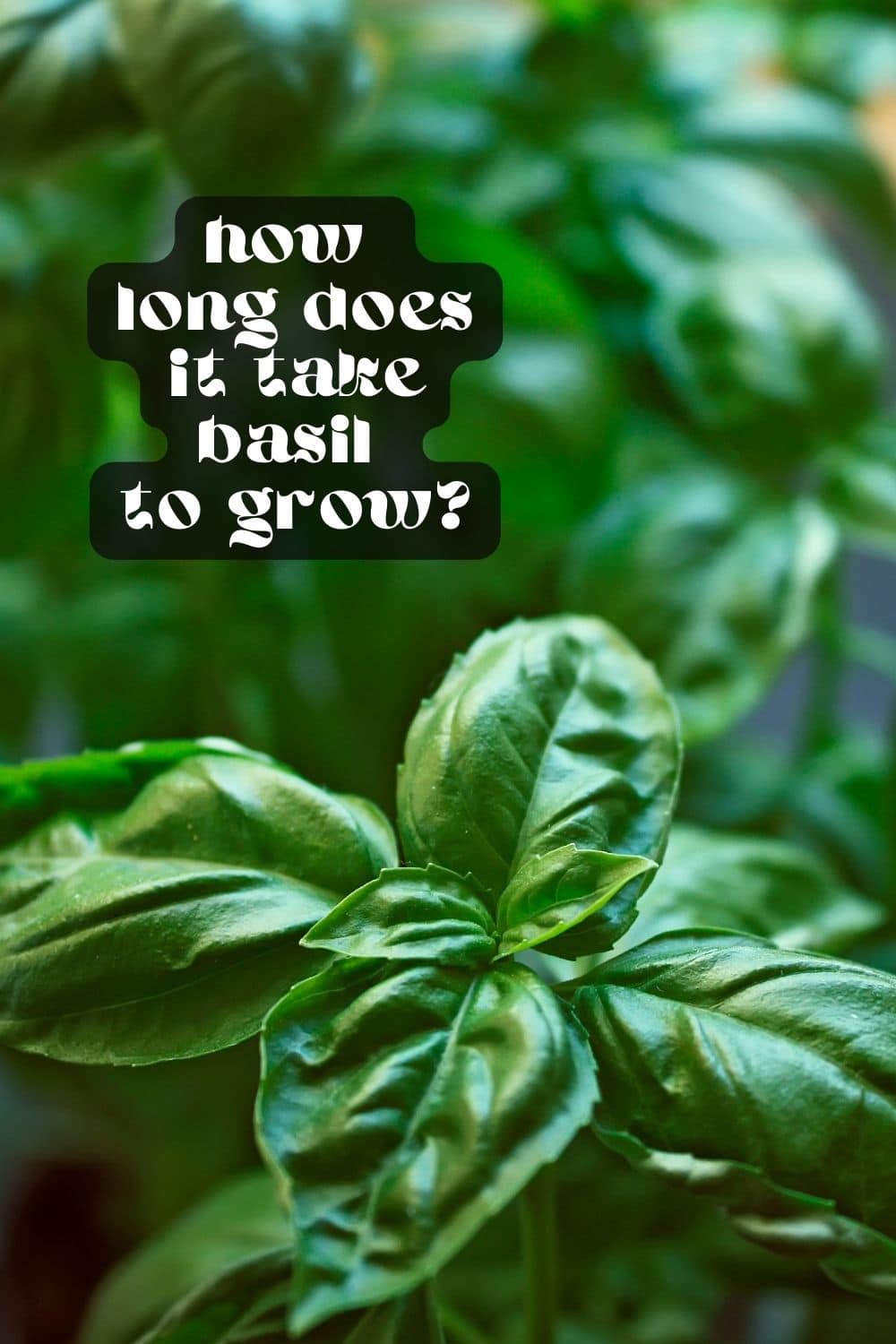
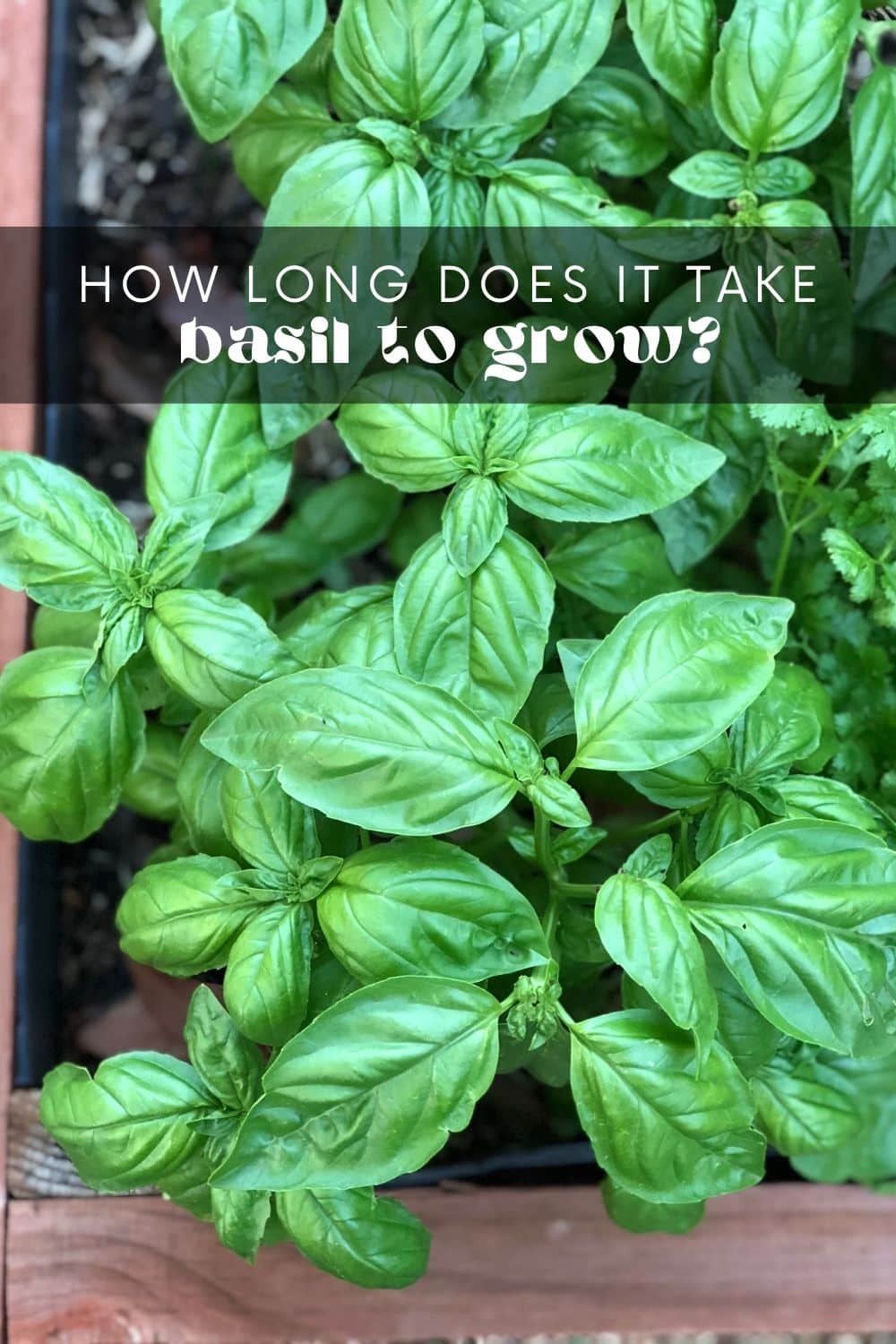
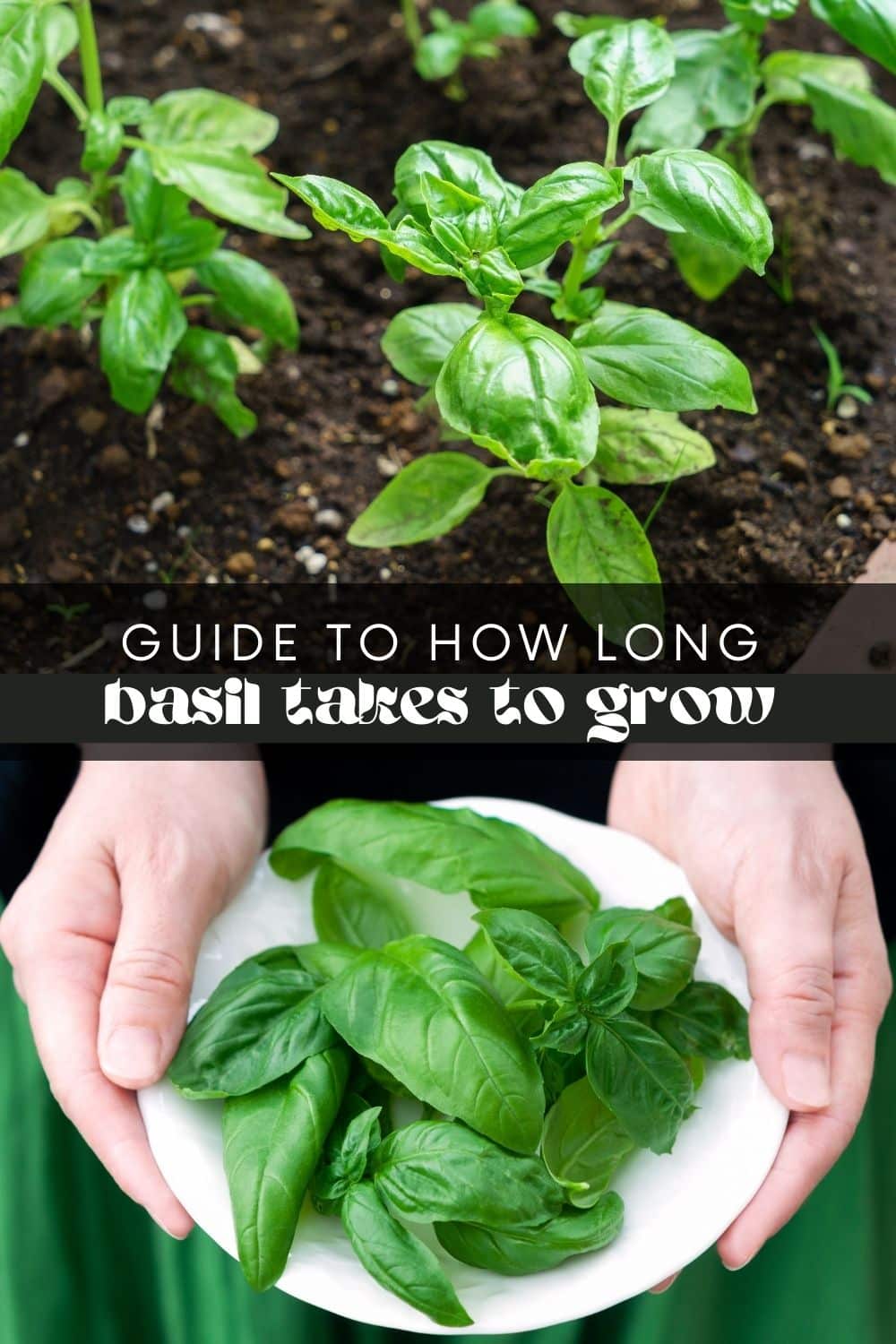





[…] How Long Does It Take Basil to Grow? […]